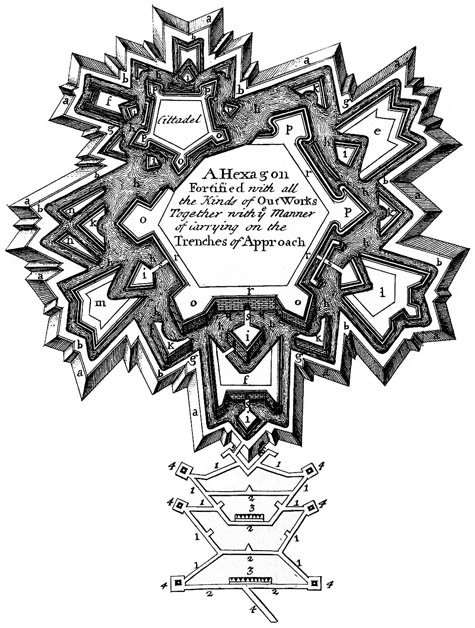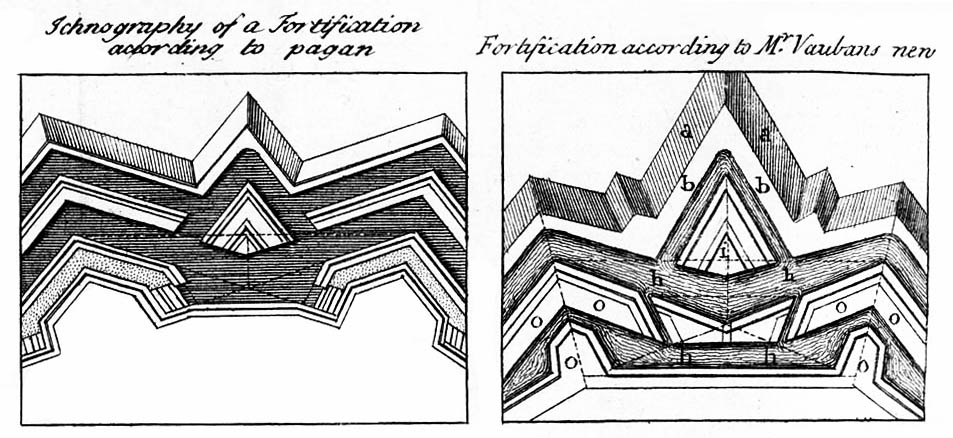The Trenches of Approach
 [Images: Photos via the BBC and the Washington Post].
[Images: Photos via the BBC and the Washington Post].A story on the BBC that I neglected to blog last week explains how the capital of Chad will soon be encircled by a gigantic trench: "A three-metre [10-foot] deep trench is being dug around Chad's capital, N'Djamena, to force vehicles through one of a few fortified gateways into the dusty city," we read.
Additionally, like some strange, new, paranoid version of Easter Island, "tree surgeons [have] cut down centuries-old trees that lined the city's main avenue for fear they could provide cover for attackers."
Prepared for war and insurgency, then, the city will strip itself bare.
"It's part of our strategy," the Interior Minister claims. These are just "initiatives to prevent attacks from rebels based in the east of the country."
It's also interesting to note, though, that, in the absence of enemy air power, basic urban design moves – like trenches and gates – can still be used as an effective tactic of defense during war.
 [Image: The "trenches of approach," via Wikipedia; view larger].
[Image: The "trenches of approach," via Wikipedia; view larger].In fact, I'm reminded of Alberto Pérez-Gómez's book, Architecture and the Crisis of Modern Science, in which he writes about the geometric history of urban fortifications – such as those seen on Deputy Dog last month.
As Pérez-Gómez writes, referring to military treatises produced in western Europe in the 16th and 17th centuries: "All military problems were described in terms of lines and angles..."
War, to put it glibly, was a function of measurement and trigonometry.
Bernard Palissy, in particular, a 17th century theoretician and builder of fortified space, discovered that some of the best military geometries were to be found in the bodies of maritime organisms:
- Palissy believed that existing fortified towns failed because their protecting walls were not really part of the towns' architecture. He tried to find better ideas in the treatises of the old masters, but was sadly disappointed. In desperation, he turned to nature and after traversing woods, mountains, and valleys, he arrived at the sea. It was there that he observed "the miraculous protection of mollusks like oysters and snails."
What's particularly interesting about this, however, is that Palissy – and other military architects of the time – saw fortified cities as all but divinely ordained; quoting an architect named Jacques Perret de Chambéry, Pérez-Gómez notes that military architecture "could thus represent an order in which 'all nations may praise the Lord' and 'live according to His Holy Laws.'"
Military architecture was, to this way of thinking, religious architecture.
 [Image: Star fort diagrams, via Wikipedia].
[Image: Star fort diagrams, via Wikipedia].Things even got a bit Da Vinci Code here. For instance, we read that certain military architects "recommended the use of square, pentagonal, or hexagonal fortifications since these figures were symbols of the relation between the human body and the cosmos." Further, dividing space within these fortified cities into four distinct parts meant that the space could correspond "to the four regions of the sky, thus emulating the cosmic order."
In fact, Pérez-Gómez notes, a man named Mathias Dögen even included, in a treatise on war and space, "long sections in which he provided detailed instructions on how to conquer cities, taken from the 'Laws' established in the Holy Scriptures."
This idea – that military architecture was a way to inscribe "cosmic order" onto the surface of the earth – is almost ridiculously interesting. How does that play out today – in Camp Bondsteel, for instance?
But even the briefest suggestion that something as tactical, pragmatic, and strategically rooted in measurement as 17th century European warfare might actually have harbored this mystical underside surely deserves more exploration elsewhere.
 [Image: Star fort diagrams, via Wikipedia].
[Image: Star fort diagrams, via Wikipedia].In any case, reading this in the context of today's War on Terror – with its slow encroachment of blast walls and other anti-terror architecture into the very heart of our now fortified cities – I'm led to ask if we might be witnessing the makeshift inscription of a new sort of "cosmic order" into urban space, worldwide.
Or, to put it another way: How do well-fortified Western cities in an age of Global Terror give shape to, or represent, much larger, more subtle, and perhaps immaterial details of a religious world view?
Might we yet see a religious theorization of 21st century urban space, in which anti-terror architecture plays a central role?
Is there an underexplored theological dimension to crash barriers, Bremer walls, and armed checkpoints?
That may wildly overstate the case, of course – but I'm reminded of an article in Salon, published way back in 2006, where we read:
- To appreciate how America has changed since 9/11, walk slowly through any major city. What you'll see dotting the landscape is the physical embodiment of fear. Security installations put up after the attacks continue to block public access and wrangle pedestrian traffic. Outside Manhattan's Port Authority Bus Terminal, garish purple planters menace rush-hour pedestrian traffic. The gigantic planters have abandoned all horticultural ambition, many of them blooming with nothing more than trash and untilled dirt.
- It's not just the barriers, it's also the buildings. Since 9/11, risk consultants working for police departments, federal agencies and insurance companies have wrested control over many new construction plans. "There's a sense that security experts are acting as the associate architects on every project built today," says Paul Goldberger, the architecture critic of the New Yorker. Consultants tend to encourage architectural bulk at the expense of grace.
 [Image: A photo by Randy of a fortified road on the way to Rachel's Tomb, Bethlehem – an old city of stone walls overshadowed by a new city of concrete blast walls].
[Image: A photo by Randy of a fortified road on the way to Rachel's Tomb, Bethlehem – an old city of stone walls overshadowed by a new city of concrete blast walls].So if religiously inspired military architects of the 17th century were the "risk consultants" and urban "security experts" of their day, then how might their treatises read if updated for the War on Terror?





Comments are moderated.
If it's not spam, it will appear here shortly!
Is it coincidence that you are writing about this now, not but one week before coming to Baltimore where you will find this:
Fort McHenry
I did a paper on Megastructure, and realized through research in fortified cities, that they are almost classifiable as Mega Structure. Which if you use Ponte Veccio, London Bridge, Arcosanti, and Aircraft carriers as the examples, thus it follows that a city that is formed by it's walls is nearly mega structure.
The rub comes with the question: how well are the avenues connected to the skeleton? S. Gionno is a great example of multi level connections in that the towers had temporary bridges from tower to tower so they could escape from a window into a friendly neighbor's tower when surrounded by angry peasants. Yeh... I'm sure that worked ONCE!
A city wall is, of course, easily penetrated by a terrorist, so these days we must choose what to protect within the city. A walled city somehow implies that all within is valued—life and property—while the new barricades are more specific. We are designating the holy places and revealing a kind of spiritual zeitgeist in the process.
your post reminded me of the opening of "austerlitz" by w.g. sebald. it's all about the remnants of military fortifications and includes old arial diagrams similar to what you've posted here.
Speaking of walls, what to think about this prison ?
Along with those purple planters in front of the NY Port Authority, the CALTRANS building in LA comes to mind. There was a whole debate criticizing the building being incredibly in-urban because its surrounded on all four sides by a 4 meter tall concrete wall, that comes right to the sidewalk. While Council member Jan Perry might be fighting for Mixed use in downtown LA, the FEDS have infiltrated Thom Mayne's office yielding a riot shield and a red sharpie.
nice to see a reference to vauban.
i spent a few days w/ my dad the military history buff in vauban's neuf breisach
http://www.gruene-strasse.de/assets/adb/img_97_5.jpg
Not related to trenches, but PingMag just had a post about Geospatial Technology: Mapping For Human Rights, which included references to the Madoua settlement in Chad before its destruction. PingMag's piece is an interview with Geospatial Technologies and Human Rights Project's director, Lars Bromley. Thought you might find it interesting!
Thanks, Yule - I'll check it out.
And, anonymous, I had totally forgotten about the fort references in Austerlitz - I'll have to reread that this summer! Thanks for mentioning it.
And the Ft. McHenry thing is, indeed, a coincidence... I've driven through the Ft. McHenry Tunnel many times, however.
if only we COULD invest a little bit more meaningful design into our burgeoning security infrastructure and have it stand even the remotest chance of not being value-engineered to death.
so... you think that selling it with talk of spiritual predeterminism and cosmology might get us there?!
Post a Comment